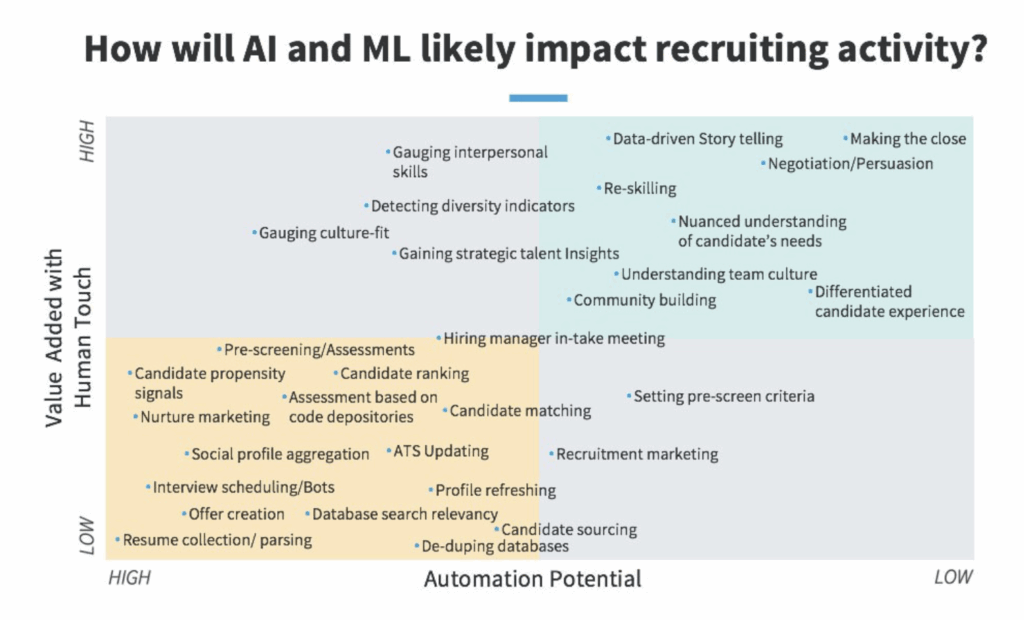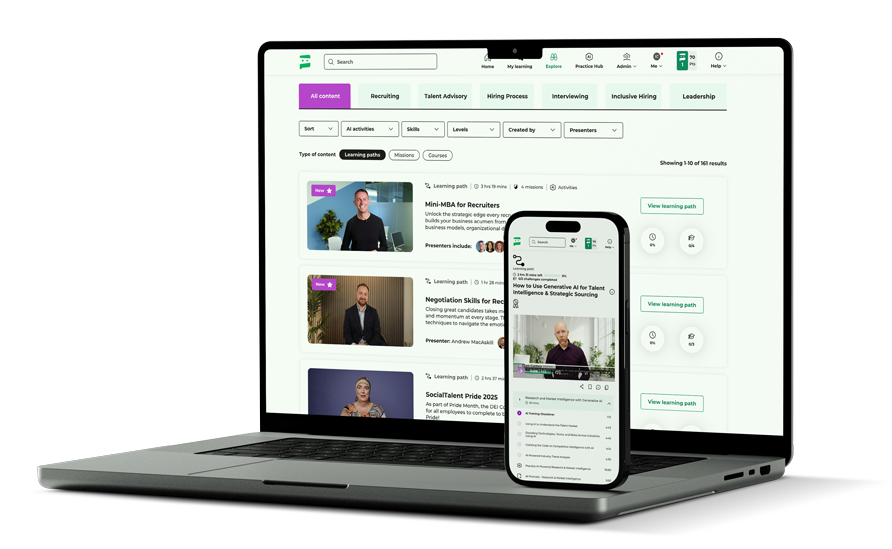
By Johnny Campbell
How AI recruiting technology is transforming hiring today – and what comes next.
I spent an hour last week talking to a TA team at one of the world’s biggest tech companies. They’d seen a few of the pieces we’ve written about AI in hiring and the future of hiring and wanted a sounding board conversation to figure out where their own hiring strategy should go next. Why? Because they don’t know.
And that’s not a unique position by any stretch.
I’ve had similar conversations with countless other organizations and talent teams over the last few months. No-one knows what’s truly coming.
But here’s the interesting part: everyone is still building for a future they can’t quite define yet.
While the uncertainty of the unknown can be paralyzing, it can also be clarifying. Because while we don’t know exactly what hiring will look like in five years, we do know enough to start making better decisions today.
Let’s talk about what’s already here, what’s just ahead, and what we should probably stop pretending is going to “go back to normal.”
How AI Is Transforming Hourly Hiring Right Now
If you want a glimpse of how AI recruiting technology is already reshaping the hiring process, don’t look at high-tech companies or white-collar exec roles. Look at retail. Look at logistics. Look at hourly hiring. We’re already seeing processes revolutionized by AI where someone can go from “I’m interested” to “you’ve got the job” in seven minutes.
Not a pipe dream. Not a concept. That’s live in multiple markets right now. The results? Better candidate satisfaction. Happier managers. Lower attrition. More diverse hiring outcomes. And yes, it’s cheaper.
It’s a rare moment where the speed, quality, and cost triangles all align. And no one’s missing the old way in this market. This is important because it breaks the narrative that “AI will eventually change hiring.”
It already has.
The only real question now is: when will the rest of us catch up?
Side note: Our next SocialTalent Live event is actually dedicated to this very topic of automating high-volume hiring with the likes of Matt Lavery from UPS joining us to share their story. Snag a seat if this topic is of interest!
AI Recruiting Automation: The ‘Before the Interview’ Tipping Point
We’ve long said that most of the hiring process can be automated – up to the interview itself. That used to sound bold. It doesn’t anymore.
Today, thanks to AI recruiting automation, you can take a voice note from a hiring manager and turn it into a fully functional job ad. You can automatically post it, promote it, generate campaigns, manage inbound and outbound outreach, screen the responses, and produce a shortlist.
No humans required.
Is the tech perfect? No. Is it better than every recruiter? No. But it’s already better than half. That’s not a dig. It’s just the curve. And if you’re running a Level 1 TA function – low maturity, high inefficiency – then it’s likely that automation is already a performance upgrade.
But if you’re at Level 4? Where recruiters are deeply aligned with the business, where your messaging and targeting are tight, where you’ve built trust with hiring managers? Then no. The tech’s not better. Yet.
But don’t confuse “not better” with “not ready.” Because it’s already cheaper. And faster. Which means the pressure isn’t going away.
Learn more: Track where you are on the Hiring Excellence Maturity Model
Agentic Interviews: The Next Wave of AI Recruiting Technology
Now, here’s where things get strange…
We’ve been talking a lot lately about agentic interviews – AI-led interviews that function as asynchronous conversations with candidates. Not just screeners. Real interviews.
You might be tempted to think: “Sure, that’ll only work for junior roles.”
Not so. I was told a story from Glen Cathey recently about a million-dollar-salary surgeon who completed their interview in four asynchronous sessions with an AI interviewer. Started, paused, resumed at their convenience. No human interviewer would have flexed like that. The candidate got a seamless experience; the company got their time back.
That’s not just “good enough.” That’s better.
I also spoke to Pavan Kumar at Eightfold in advance of an upcoming podcast we’re recording, who’s now hired dozens of engineers in India through agentic interviews. Feedback? Overwhelmingly positive. Most candidates preferred it and only one opted out.
This isn’t about removing humans. It’s about removing friction.
Surely this is the future?
And Yet… It’s Not the Destination. It’s Just the Bridge.
Agentic interviews are certainly delivering huge upside. You can interview 10x more candidates, widen the aperture, hire more inclusively. There’s a plethora of benefits. But think a few steps ahead.
If every company scales agentic interviewing, candidates will be asked to do 10x or 100X more interviews – often answering the exact same questions. The friction shifts from scheduling to fatigue.
Candidates won’t keep doing it. They’ll opt out.
So yes, agentic interviews will scale. Then they’ll break. And they’ll be replaced. Not with humans though, but with newer tech that solves for the next problem.
Agentic interviews in their current state aren’t the final form. They’re a bridge.
Think about the first time you saw someone wear AirPods. They looked ridiculous, right? Now, they’re the norm. The tech didn’t change. We did. And that’s what we’re going to see with agentic interviews. Google are betting (again) that wireless buds and current smartphones will be replaced by glasses, the new form factor.
Right now, in terms of hiring, it still sounds futuristic and maybe a bit soulless. But when it becomes normal – when the benefits far outweigh the failings – attitudes will shift fast.
So What Do You Do Now? Build Your Roadmap
If you’re serious about staying ahead, you need to build two parallel plans:
One is your tech roadmap:
Audit your hiring process. Identify the friction points. Automate everything that doesn’t require human judgment, empathy, or creativity. (And be honest about what those things really are.)
The second is your skills roadmap:
Because if your people aren’t spending time doing admin anymore, what will they be doing? They’ll be doing one of three things:
- Working with the business
- Working with candidates
- Working with the tech
That’s the future of recruiting: fewer tasks, more impact. You don’t need a crystal-clear org chart to move forward – just a clear sense of where humans matter most. Start with that. Build toward it. And trust that the teams who lean into this shift now will be the ones still standing when the dust settles.
I know this, because this is the future we’ve been pushing towards for years. There’s a framework you may have seen – originally published by LinkedIn eight years ago. It maps hiring activities along two axes: how easy they are to automate, and how much value humans add.

The bottom-left? That’s the admin. Interview scheduling, database updates, basic sourcing. No-brainer automation territory. The top-right? The high-touch stuff – storytelling, closing, deep candidate care. That’s what humans will probably always own.
So this isn’t really a 2025 blueprint. It’s a 2017 slide. You’ve just been ignoring it!
One Last Thing: Ignoring This is No Longer an Option
There was a time when ignoring AI in hiring just meant being a bit behind.
That time is over.
If you’re trying to hire hourly workers today without an automated, AI-powered process, you’re losing candidates. You’re slower, clunkier, and less responsive – and people are opting out before you even see them.
And in professional hiring, the candidates you want will soon expect a smoother, more human-like experience that just happens to be powered by machines. So yes – this moment brings uncertainty. But it also brings opportunity.
And if you’re in the top half of the profession – if you’re good – you’re probably going to be fine. If you’re not? Then it’s time to decide if you want to be.
AI recruiting technology isn’t a hypothetical — it’s active and evolving. Teams that embrace automation, agentic interviews, and human-AI collaboration will be best positioned to thrive in this next era of hiring.
This article originally appeared in Johnny Campbell’s Talent Leadership Insights LinkedIn newsletter. Click here to subscribe!




